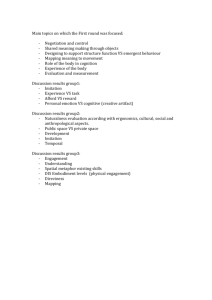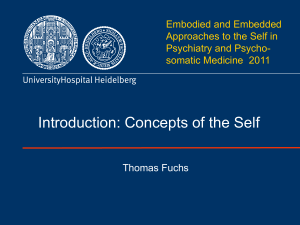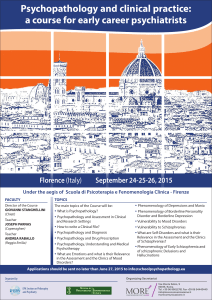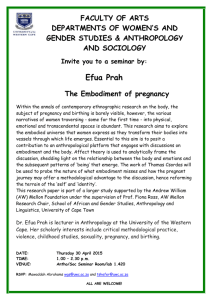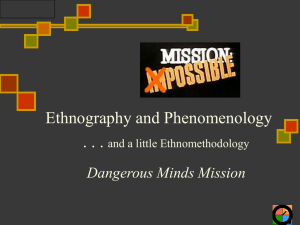Embodiment and psychopathology: a phenomenological perspective
advertisement
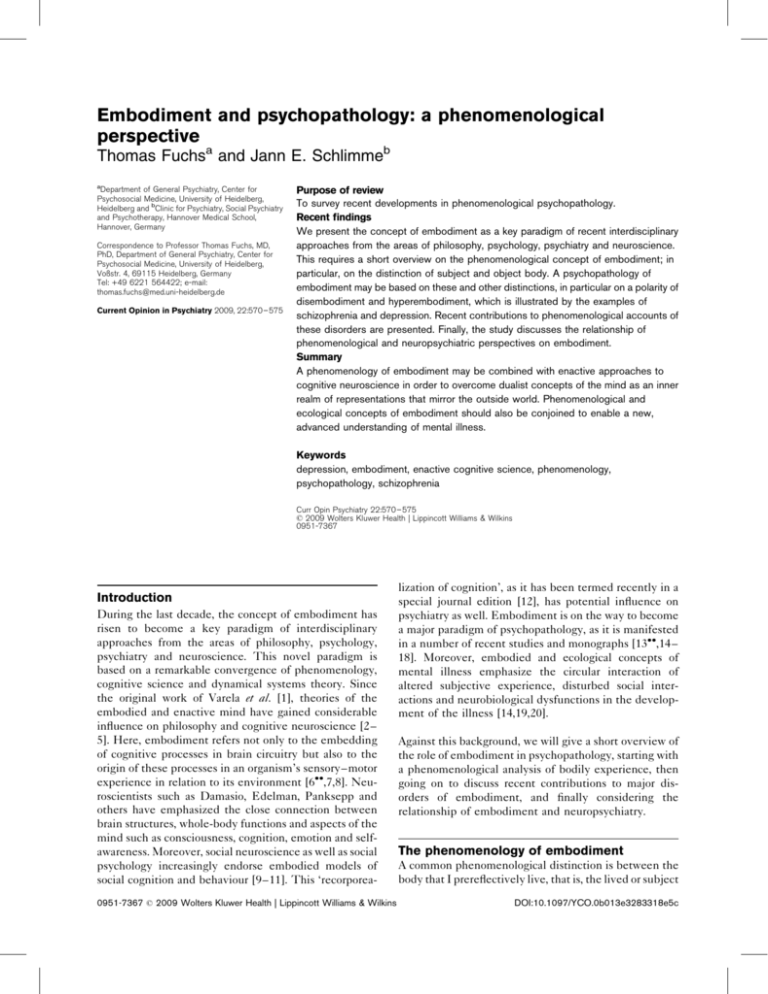
Embodiment and psychopathology: a phenomenological perspective Thomas Fuchsa and Jann E. Schlimmeb a Department of General Psychiatry, Center for Psychosocial Medicine, University of Heidelberg, Heidelberg and bClinic for Psychiatry, Social Psychiatry and Psychotherapy, Hannover Medical School, Hannover, Germany Correspondence to Professor Thomas Fuchs, MD, PhD, Department of General Psychiatry, Center for Psychosocial Medicine, University of Heidelberg, Voßstr. 4, 69115 Heidelberg, Germany Tel: +49 6221 564422; e-mail: thomas.fuchs@med.uni-heidelberg.de Current Opinion in Psychiatry 2009, 22:570–575 Purpose of review To survey recent developments in phenomenological psychopathology. Recent findings We present the concept of embodiment as a key paradigm of recent interdisciplinary approaches from the areas of philosophy, psychology, psychiatry and neuroscience. This requires a short overview on the phenomenological concept of embodiment; in particular, on the distinction of subject and object body. A psychopathology of embodiment may be based on these and other distinctions, in particular on a polarity of disembodiment and hyperembodiment, which is illustrated by the examples of schizophrenia and depression. Recent contributions to phenomenological accounts of these disorders are presented. Finally, the study discusses the relationship of phenomenological and neuropsychiatric perspectives on embodiment. Summary A phenomenology of embodiment may be combined with enactive approaches to cognitive neuroscience in order to overcome dualist concepts of the mind as an inner realm of representations that mirror the outside world. Phenomenological and ecological concepts of embodiment should also be conjoined to enable a new, advanced understanding of mental illness. Keywords depression, embodiment, enactive cognitive science, phenomenology, psychopathology, schizophrenia Curr Opin Psychiatry 22:570–575 ß 2009 Wolters Kluwer Health | Lippincott Williams & Wilkins 0951-7367 Introduction During the last decade, the concept of embodiment has risen to become a key paradigm of interdisciplinary approaches from the areas of philosophy, psychology, psychiatry and neuroscience. This novel paradigm is based on a remarkable convergence of phenomenology, cognitive science and dynamical systems theory. Since the original work of Varela et al. [1], theories of the embodied and enactive mind have gained considerable influence on philosophy and cognitive neuroscience [2– 5]. Here, embodiment refers not only to the embedding of cognitive processes in brain circuitry but also to the origin of these processes in an organism’s sensory–motor experience in relation to its environment [6,7,8]. Neuroscientists such as Damasio, Edelman, Panksepp and others have emphasized the close connection between brain structures, whole-body functions and aspects of the mind such as consciousness, cognition, emotion and selfawareness. Moreover, social neuroscience as well as social psychology increasingly endorse embodied models of social cognition and behaviour [9–11]. This ‘recorporea0951-7367 ß 2009 Wolters Kluwer Health | Lippincott Williams & Wilkins lization of cognition’, as it has been termed recently in a special journal edition [12], has potential influence on psychiatry as well. Embodiment is on the way to become a major paradigm of psychopathology, as it is manifested in a number of recent studies and monographs [13,14– 18]. Moreover, embodied and ecological concepts of mental illness emphasize the circular interaction of altered subjective experience, disturbed social interactions and neurobiological dysfunctions in the development of the illness [14,19,20]. Against this background, we will give a short overview of the role of embodiment in psychopathology, starting with a phenomenological analysis of bodily experience, then going on to discuss recent contributions to major disorders of embodiment, and finally considering the relationship of embodiment and neuropsychiatry. The phenomenology of embodiment A common phenomenological distinction is between the body that I prereflectively live, that is, the lived or subject DOI:10.1097/YCO.0b013e3283318e5c Embodiment and psychopathology Fuchs and Schlimme 571 body (Leib), and the physical body that I can perceive or that is perceived by others, in other words, the object body (Körper) [21,22]. (1) The subject body functions as the medium and background of our experience. Although it is itself not perceived, it operates in every action and interaction with others, without requiring explicit attention. It encompasses those abilities and dispositions that are neither representations nor rules but are actualized in our everyday life in a tacit or implicit mode, before we can reflect upon our experience. It enables our understanding of the environment as a space of possible engagement and action, of objects being ‘ready to hand’ (to be grasped, to be cut, eaten, written, to dress with and so on) [23]. Thus, the lived body also corresponds to the bedrock of unquestioned certainties [24] or to ‘common sense’ as a prereflective know-how, which attunes us to the world and to others [23,25,26]. The overall experience of being-in-the-world is inseparable from how one’s body feels in its surroundings. Ratcliffe [13] has argued recently that basic bodily feelings are at the same time feelings of bodily states and ways of experiencing the world. This applies, in particular, to ‘existential feelings’ such as feeling at home, belonging to the world, having a sense of reality, or feeling distant from things or others, alienated, depersonalized and so on, as well as to atmospheric perception, for example, as in delusional mood. The sense of reality may be diminished or otherwise altered, and one might feel familiar or uncanny, engaged or detached and so on. These background feelings rooted in the body are not directed towards specific objects or situations but colour and structure one’s experience as a whole. (2) Normally, the body tends to efface itself in our worlddirected activity [27]. However, it appears as an object of conscious attention, particularly when it is inadequate for a task to be performed, be it by a lack of capacity, fatigue, illness or numbness, and whenever it becomes an object for others to whom I feel exposed. In these cases, the body’s performance is made explicit and may often be disturbed. Thus, the body has a double or ambiguous experiential status: both as a ‘lived body’, implicit in one’s ongoing experience, and as an explicit, physical or objective body. An ongoing oscillation between these two bodily modes constitutes a fluid and hardly noticed foundation of all experiencing. A closely related distinction is the one between body schema and body image. The body schema denotes a complex interplay of sensory–motor systems (e.g. the visual, vestibular, proprioceptive, kinaesthetic system), which unconsciously regulate bodily posture and move- ment in relation to the environment. The body image, on the contrary, signifies a system of conscious perceptions, emotional attitudes and conceptual beliefs that pertain to one’s body [5]. Thus, the one corresponds to an implicit operation, whereas the other to an explicit awareness of the body. On this basis, disturbances of embodiment may be classified (1) as primarily affecting the subject body or prereflective embodied sense of self; such is the case, for example, in schizophrenia or depression, or (2) as being more related to the body image or explicit body awareness. These include, for example, body dysmorphic disorder, hypochondriasis, somatoform disorders or eating disorders such as anorexia nervosa [28]. For reasons of space, we will restrict the overview to disturbances of prereflective embodiment in schizophrenia and depression. Schizophrenia as a disembodiment Current neuropsychological theories attribute the core disturbances in schizophrenia to higher order cognitive processes such as ‘theory of mind’ or ‘meta-representation’ [29,30]. In contrast, recent phenomenological approaches locate the main disorder in schizophrenia on a lower level, regarding it as a fundamental disturbance of the embodied self, or a disembodiment. This includes weakening of the basic sense of self, a disruption of implicit bodily functioning and a disconnection from the intercorporality with others. As a result of this disembodiment, the prereflective, practical immersion of the self in the world is lost. Disembodiment of self According to the theory put forward by Parnas and Sass [31,32], schizophrenia involves a diminishment of basic self-awareness, experienced as a feeling of a pervasive inner void or lack of presence [33]. The loss of the vital, embodied contact with reality may be expressed in complaints about a certain opacity of consciousness (feeling like ‘in a fog’ or ‘surrounded by invisible walls’) or a general existential feeling of being alien to the world [13]. This is often accompanied by cenesthopathic sensations of the body, which may be interpreted as a conspicuousness of otherwise latent bodily feelings, caused by a detachment of self and body [34,35]. Disorders of basic self-awareness have recently come to be explored in detail by means of an extensive, phenomenologically based interview (Examination of Anomalous Self-Experience, EASE [36]). Disembodiment of perception and action The disturbance of basic self-awareness in schizophrenia can be understood in two ways: (a) it is accompanied by a 572 History and philosophy loss of automatic processing, leading to an increasing fragmentation of perceptual and motor schemas [17,34]; and (b) it is the result of this impaired preintentional automatic processing (‘passive synthesis’) [37]. In any case, the fragmentation of habitual schemas leads to a ‘pathological explication’ of implicit bodily functions [17], which means that normally tacit sensory–motor processes become available for conscious introspection. In perception, the disembodiment manifests in an impaired ability to recognize familiar patterns of perceived objects. Patients often experience an overload of details separated from the situational context, without grasping their meaning. With growing alienation, even the act of perceiving itself may come to awareness. Then, the patients are like the spectators of their own perceptive processes: ‘I saw everything I did like a film-camera’ [38] (p.132). This alienation of perception turns the objects into mere appearances or phantoms, hence the artificial, enigmatic alteration of the environment experienced in predelusional perplexity [39,40]. At the same time, new, idiosyncratic saliencies may emerge, that is, expressive qualities, strange features of persons and faces or hypersignificant objects standing out from the incoherent background. Over the course of time, these noncontextualized fragments are reorganized by emerging delusions that provide a new but rigid coherence of the perceptual field by sacrificing some features while preserving others. A similar alienation concerns bodily functioning in movement and action. Patients with schizophrenia often speak of a split between their mind and their body. In particular, they may experience a disintegration of habits or automatic practices, a ‘disautomation.’ The units of meaningful actions are fragmented, resulting in a pathological explication and hyperreflexive awareness of normally tacit aspects of everyday behaviour [32]. Instead of simply dressing, driving, walking and so on, patients have to prepare and produce each single action deliberately. In advanced stages, the sense of agency for one’s actions (i.e. the sense that I am the one initiating the movement) may be disrupted, finally leading to delusions of alien control [5] (p.173ff.) Disembodiment of intercorporality and ‘common sense’ As said before, the lived body also conveys the practical knowledge of how to interact with others and how to understand their expressions and actions against the background of the common situation. Thus, we are involved in a sphere of primary ‘intercorporality’ [21]. This tacit or enacted knowledge is also the basis of ‘common sense’: the practical immersion in the life-world develops from birth through interactions with others. It provides a fluid, automatic and context-sensitive preunderstanding of everyday situations, thus connecting self and world through a basic habituality and familiarity. If this embodied involvement in the world is disturbed, this will result in a fundamental alienation of common sense and intersubjectivity; the basic sense of being-withothers is replaced by a sense of detachment that may pass over into a threatening alienation. Thus, the behaviour of others comes to be observed from a distant or a third person point of view instead of entering second person embodied interactions. Patients report feeling isolated and detached, unable to grasp the natural, everyday meanings of the common world. As a result, interpersonal relationships are in constant need of being reconstructed by deliberate efforts, leading to constant stress in complex social situations and finally to autistic withdrawal [25,34]. In summary, from a phenomenological perspective, schizophrenia implies a disembodiment of the self in the sense of losing one’s implicit body functioning, and with it the prereflective, questionless being-in-the-world that is mediated by the body. As the sense of self is bound up with the sense of others, disembodiment of self and disturbance of intercorporality mutually influence each other, resulting in a ‘loss of natural self-evidence’ [41], a lack of tacit attunement to other people and situations. Melancholic depression as ‘hyperembodiment’ A different disturbance of embodiment is found in melancholic depression. Here, the body loses the fluidity and transparency of a medium and becomes conspicuous, turning into a heavy, solid body, which puts up resistance to the individual’s intentions and impulses. Its materiality and weight, otherwise suspended in everyday performance, comes to the fore and is experienced as a leaden heaviness, oppression and rigidity (e.g. a feeling of a tyre around the chest, pressure in the head or as general tightness and anxiety). Restricted gait patterns associated with depressed mood have been identified recently [42]. Thus, instead of giving access to the world, the body stands in the way as an obstacle, separated from its surroundings: phenomenal space is not embodied any more. However, this is not only due to psychomotor inhibition (as, for example, in Parkinson’s disease). Rather, the conative dimension of the body, that is, its affective and appetitive directedness, is lacking or missing. Normally, it is this dimension that opens up the peripersonal space as a realm of possibilities, ‘affordances’ and goals for action. In depressive patients, however, drive and impulse, appetite and libido are reduced or lost, no more disclosing potential sources of pleasure and satisfaction. Confined to the present state of bodily restriction, depressive patients cannot transcend their body any more. The open horizon of possible experiences shrinks into a locked atmosphere, Embodiment and psychopathology Fuchs and Schlimme 573 in which everything becomes permeated by a sense of lost possibilities. With growing inhibition, sensory–motor space is restricted to the nearest environment, culminating in depressive stupor. Thus, melancholia may be described as a reification or ‘corporealization’ of the lived body, or as a ‘hyperembodiment’ [17]. At the same time, there is a more subtle loss of the bodily resonance or affectability that mediates emotional experience and the affective attunement with others. As the corporealized body loses its capacity of emotional resonance, the patients feel inanimate, detached from their emotions and complain of a ‘feeling of not feeling’. They are no longer capable of being moved and affected; the attractive and sympathetic qualities of their surroundings have vanished. As loss of feeling means a diminished sense of self, affective depersonalization is the clinical core feature of severe melancholic episodes [16,17]. In some cases, the depersonalization culminates in the socalled nihilistic delusions or Cotard’s syndrome [13,43] (p.165ff.). Patients then claim that they have already died, and their body has turned into a corpse. They may even deny their own existence or the existence of the world. This can be understood as a separation of the ‘pure’, unaffected consciousness from the corporealized body, whose heaviness now changes to the opposite, that is, a feeling of lightness or even to a complete loss of bodily sensations: proprioception, taste, smell, the sense of warmth or pain may be missing. Thus, the sense of bodily ownership or auto-affection is severely disturbed, whereas the sense of agency is still present. To summarize, the persons affected by melancholia plunge into the spatial boundaries of their own solid, material body. Instead of transcending it, they become completely identified with it; unable to detach themselves from the experience of bodily failure, they feel worthless, guilty or decaying. Although this may be termed ‘hyperembodiment’, in the nihilistic culmination of melancholia, the self disconnects from the corporealized body, and the basic sense of being alive is lost. This kind of disembodiment is not restricted to depression but occurs in other depersonalization syndromes as well, in which the affective sense of self is disintegrated and the body is experienced as an object among others [44]. Finally, a more acute dissociation from body experience is found in posttraumatic and dissociative disorders [45]. Embodiment and neuropsychiatry On the neurobiological level, the emergence of bodily experience requires a complex integration of multiple sensory inputs (visceral, proprioceptive, motor, vestibular, visual and so on). Various neurological disorders are defined by aberrations in bodily experience, including the perceptual ablation or disembodiment of body parts, ‘filling in’ of amputated limbs or reduplication of body parts [46]. Similarly, embodied concepts of mental illness may be related to dysfunctions on the neurophysiological level. Thus, the concept of disembodiment in schizophrenia can be regarded as corresponding to a maturational disorder of connectivity, which normally links different regions of the cortex to each other and to subcortical structures. The resulting lack of intermodal integration could result in an impaired development of the embodied or ‘ecological self’ and its perceptual, cognitive and emotional ties with the environment [47]. In particular, intercorporal alienation, as manifested by abnormalities in a wide range of social cognition tasks, points to a disorder of the complex ‘social brain’ network that is a characteristic of humans [48]. On the contrary, concepts of embodiment, from the phenomenological as well as from the dynamic systems point of view, are opposed to mind–brain identity models. Instead, they regard both subjective experience and brain processes as being inseparably linked with the environment. From birth, it is mainly through our embodied interaction with the world and with others that the brain matures and develops into a ‘relational organ’ [7]. The relationships and meanings experienced in these interactions come to be sedimented in the organism in the form of neuronal circuits and excitation patterns. Once developed, these organic dispositions may then be actualized in accordance with the present situation, thus functionally connecting organism and environment. However, it is only as a part of embodied interactions that the patterns of brain activity can serve as carrier processes of conscious experience. In this way, it is the living body itself that unites mind and brain. From the above discussion, it follows that mental disorders are not to be considered as mere ‘brain dysfunctions’. Rather, they are disturbances of a person’s beingin-the-world, or, in systems terms, disturbances in the ecological interactions of an individual with his environment, mediated by the brain (with its role varying between merely functional or structural anomalies). As we have pointed out, they always manifest themselves in particular disturbances of embodied existence, even if only in the way of very basic ‘existential feelings’ [13]. Moreover, the subjective experience of the illness, on its part, is able to influence brain functioning. Evidence from neuroimaging studies of psychotherapy and placebo treatment demonstrates that beliefs and expectations can significantly modulate neurophysiological and neurochemical activity in brain regions involved in perception, movement, pain and various aspects of emotion processing [49]. These studies strongly support the view that the subjective nature and intentional content of mental processes has an impact on various levels of brain functioning (e.g. molecular, cellular, neural circuit) as well as 574 History and philosophy on brain plasticity. Furthermore, these findings indicate that variables of subjective experience have to be seriously taken into account to reach a correct understanding of the neural bases of behaviour in humans. Our mental states are products of a circular causation consisting of neurophysiological, environmental and subjective or intentional influences interacting with each other in a series of feedforward and feedback loops [7,19,20]. Mental disorders result from disturbances in these processes, but, regardless of where the disturbance starts, it will always affect the whole cycle of mind–brain and organism–environment interactions. conjoined to enable a new, advanced understanding of mental illness. This is in precise correspondence to the phenomenological account; just as the living organism can be grasped only in relation to its environment, so subjectivity is conceivable only as an embodied relation to the world [8]. Consequently, the role of phenomenology is twofold; by developing concepts of the fundamental changes of embodied existence in mental illness, it is capable (1) of giving an adequate account of the subjective experience of an illness, thus providing the basis for sound neurobiological research, and (2) of understanding the patient’s condition in terms of being with others, or in relation to the life-world, thus providing the basis for ecological approaches to social psychiatry and psychotherapy [50]. Conclusion We have presented the concept of embodiment as a novel paradigm for an interdisciplinary approach to psychopathology and neuroscience. On the one hand, the phenomenology of the lived body is able to overcome dualistic concepts of the mind as an inner realm of representations that mirror the outside world. Instead, by the mediation of the living body, the individual is in constant relationship to the world and to others; intercorporality or embodied interaction is the basis of social cognition [51]. On the other hand, the neurocognitive system cannot be grasped separately: it exists only as enmeshed in the world in which we move, behave and live with others through our bodily existence. So, instead of representationalism with its fixed inside–outside distinction, we need embodied and enactive concepts of cognitive neuroscience that are in correspondence to the phenomenology of the lived body. Similarly, embodied concepts of mental illness have to take both sides into account: they should, on the one hand, describe and understand the patient’s being-in-the-world by using phenomenological methods, whereas, on the other hand, they should investigate the circular interactions of mind, brain, organism and environment in the cause and maintenance of psychiatric disorders. Thus, phenomenological and ecological concepts of embodiment could be References and recommended reading Papers of particular interest, published within the annual period of review, have been highlighted as: of special interest of outstanding interest Additional references related to this topic can also be found in the Current World Literature section in this issue (p. 654). 1 Varela FJ, Thompson E, Rosch E. The embodied mind: cognitive science and human experience. Cambridge: MIT Press; 1991. 2 Lakoff G, Johnson M. Philosophy in the flesh: the embodied mind and its challenge to western thought. New York: Basic Books; 1999. 3 Clark A. Being there. Putting brain, body and world together again. Cambridge: MIT Press; 1997. 4 Hurley SL. Consciousness in action. Cambridge: Harvard University Press; 1998. 5 Gallagher S. How the body shapes the mind. New York: Clarendon Press; 2005. 6 Thompson E. Mind in life. In: Biology, phenomenology, and the sciences of mind. Cambridge: Harvard University Press; 2007. Similarly recommendable as an integration of dynamical systems theory, biology, phenomenology and cognitive science. The main thesis is the continuity of mind and life as intrinsically related, self-organizing phenomena. 7 Fuchs T. The brain as a relational organ. A phenomenological and ecological concept [in German]. Stuttgart: Kohlhammer; 2008. 8 Fuchs T. Embodied cognitive neuroscience and its consequences for psychiatry. Poiesis Praxis 2009; 6:219–233. 9 Gallese V. The manifold nature of interpersonal relations: the quest for a common mechanism. Phil Trans R Soc Lond B 2003; 358:517–528. 10 Barsalou LW, Niedenthal PM, Barbey AK, Ruppert JA. Social embodiment. In: Ross BH, editor. The psychology of learning and motivation. San Diego, CA: Academic Press; 2003. pp. 43–92. 11 Niedenthal P, Barsalou LW, Winkielman P, et al. Embodiment in attitudes, social perception, and emotion. Pers Soc Psychol Rev 2005; 9:184– 211. 12 Heiner BT. Guest editor’s introduction. Special issue ‘The recorporealization of cognition in phenomenology and cognitive science’. Cont Philos Rev 2008; 41:115–126. 13 Ratcliffe M. Feelings of being. Phenomenology, psychiatry and the sense of reality. Oxford: Oxford University Press; 2008. A phenomenological investigation of the phenomena largely neglected by mainstream psychopathology; namely, the basic existential feelings that are mediated by the lived body. 14 Matthews E. Merleau-Ponty’s body-subject and psychiatry. Int Rev Psychiatry 2004; 16:190–198. 15 Matthews E. Body-subjects and disordered minds. Treating the whole person in psychiatry. Oxford: Oxford University Press; 2007. 16 Stanghellini G. Disembodied spirits and deanimated bodies: the psychopathology of common sense. Oxford: Oxford University Press; 2004. 17 Fuchs T. Corporealized and disembodied minds. A phenomenological view of the body in melancholia and schizophrenia. Philos Psychiatry Psychol 2005; 12:95–107. 18 MacLachlan M. Embodiment. Clinical, critical and cultural perspectives on health and illness. Maidenhead: Open University Press; 2004. 19 Fuchs T. Neurobiology and psychotherapy: an emerging dialogue. Curr Opin Psychiatry 2004; 17:479–485. 20 Glannon W. Our brains are not us. Bioethics 2009; 23:321–329. 21 Merleau-Ponty M. Phenomenology of perception. London: Routledge and Kegan Paul; 1962. 22 Plessner H. The stages of organic life and the human being: collected works IV. Frankfurt am Main: Suhrkamp; 1981. 23 Stanghellini G. Embodiment and schizophrenia. World Psychiatry 2009; 8:56–59. 24 Wittgenstein L. On certainty. London: Blackwell Publishers; 1974. 25 Blankenburg W. First steps toward a ‘psychopathology of common sense’. Philos Psychiatry Psychol 2001; 8:303–315. Embodiment and psychopathology Fuchs and Schlimme 575 26 Fuchs T. The tacit dimension. Commentary to W. Blankenburg’s ‘Steps towards a psychopathology of common sense’. Philos Psychiatry Psychol 2001; 8:323–326. 27 Leder D. The absent body. Chicago: University of Chicago Press; 1992. 28 Fuchs T. Phenomenology and psychopathology. In: Gallagher S, Schmicking D, editors. Handbook of phenomenology and the cognitive sciences. Dordrecht: Springer (in press). 29 Frith CD. Schizophrenia and theory of mind. Psychol Med 2004; 34:385–389. 30 Frith CD. The cognitive neuropsychology of schizophrenia. Hillsdale: Earlbaum; 1992. 31 Parnas J, Sass LA. Solipsism, self, and schizophrenic delusions. Philos Psychiatry Psychol 2001; 8:101–120. 40 Stanghellini G. Schizophrenic delusions, embodiment, and the background. Philos Psychiatry Psychol 2008; 15:311–314. 41 Blankenburg W. The loss of natural self-evidence. Berlin: Springer; 1971. 42 Michalak J, Troje NF, Fischer J, et al. Embodiment of sadness and depression: gait patterns associated with dysphoric mood. Psychosom Med 2009; 71:580–587. 43 Enoch MD, Trethowan WH. Uncommon psychiatric syndromes. Bristol: John Wright; 1991. 44 Lawrence EJ, Shaw P, Baker D, et al. Empathy and enduring depersonalization: the role of self-related processes. Soc Neurosci 2007; 2:292– 306. 32 Sass LA, Parnas J. Schizophrenia, consciousness, and the self. Schizophrenia Bull 2003; 29:427–444. 45 van der Kolk BA. Posttraumatic stress disorder and the nature of trauma. In: Solomon MF, Siegel DJ, editors. Healing trauma. Attachment, mind, body, and brain. New York: Norton; 2003. pp. 168–195. 33 Raballo A, Sæbye D, Parnas J. Looking at the schizophrenia spectrum through the prism of self-disorders: an empirical study. Schizophr Bull 2009 [Epub ahead of print] 46 Giummarra MJ, Gibson SJ, Georgiou-Karistianis N, Bradshaw JL. Mechanisms underlying embodiment, disembodiment and loss of embodiment. Neurosci Biobehav Rev 2008; 32:143–160. 34 Sass LA. Schizophrenia, self-experience, and so-called ‘negative symptoms’. In: Zahavi D, editor. Exploring the self. Amsterdam: Benjamins; 2000. pp. 149–182. 47 Parnas J, Bovet P, Zahavi D. Schizophrenic autism: clinical phenomenology and pathogenetic implications. World Psychiatry 2002; 1:131–136. 35 Jenkins G, Röhricht F. From cenesthesias to cenesthopathic schizophrenia: a historical and phenomenological review. Psychopathology 2007; 40:361–368. 48 Beauregard M. Mind does really matter: evidence from neuroimaging studies of emotional self-regulation, psychotherapy, and placebo effect. Prog Neurobiol 2007; 81:218–236. 36 Parnas J, Moeller P, Kircher T, et al. EASE: examination of anomalous selfexperience. Psychopathology 2005; 38:236–258. 49 Burns J. The social brain hypothesis of schizophrenia. World Psychiatry 2006; 5:77–81. 37 Mishara AL. Is minimal self preserved in schizophrenia? A subcomponents view. Conscious Cogn 2007; 16:715–721. 50 Fuchs T. Psychotherapy of the lived space. A phenomenological and ecological concept. Am J Psychother 2007; 61:432–439. 38 Sass LA. Madness and modernism. Insanity in the light of modern art, literature, and thought. New York: Basic Books; 1992. 51 Fuchs T, de Jaegher H. Enactive intersubjectivity: participatory sense-making and mutual incorporation. Phenomenol Cog Sci 2009 [Epub ahead of print]. A nonrepresentationalist account of intersubjectivity based on dynamic systems theory and on the phenomenology of intercorporality. 39 Fuchs T. Delusional mood and delusional perception: a phenomenological analysis. Psychopathology 2005; 38:133–139.
